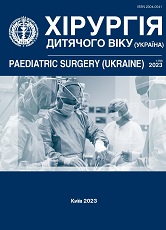Peculiarities of patients with epiglottis abscess management at all stages of medical care
DOI:
https://doi.org/10.15574/PS.2023.78.140Keywords:
epiglottitis, patient route, differential diagnosis, inflammatory diseases of the larynxAbstract
An epiglottis abscess is usually the final stage of epiglottis (epiglottitis) and surrounding tissues inflammation and can progress to life-threatening airway obstruction without treatment. The etiology of the disease can be infectious or non-infectious nature. Both with infectious and non-infectious etiology, swelling of the epiglottis occurs as a result of the accumulation of inflammatory cells in the space between the layer of squamous epithelium and the epiglottis cartilage. The lingual surface of the epiglottis and peri-epiglottis tissues have a large network of lymphatic and blood vessels, which promotes the spread of infection and the subsequent inflammatory reaction. Once the infection begins, the swelling rapidly progresses, involving the entire epiglottis of the larynx (including the epiglottis folds and the epiglottis cartilages). Clinical signs of epiglottitis vary depending on age, severity, and etiology.
Purpose - is to describe a clinical case of successful care for a child with an epiglottis abscess and the optimal route of the patient at all levels of medical care.
Clinical case. An ambulance delivered a patient G., born in 2005 (17 years old), to the emergency otorhinolaryngology department of the Kyiv City Children’s Clinical Hospital 1. During the examination in the emergency department with indirect laryngoscopy the diagnosis was established: abscess of the epiglottis. An epiglottis abscess was urgently dissected under endotracheal anesthesia. The difficulty of diagnosing an epiglottis abscess was that visualization of the larynx is possible only with the use of instrumental examination methods, such as indirect laryngoscopy. This method is not within the competence of a family doctor. Accordingly, the family doctor, within the limits of his competencies, appropriately used the ISPS-2 international classification, section «R» - respiratory system and code - «76» and made a diagnosis of acute tonsillitis, thereby assuming the infection etiology of the disease. The family doctor, taking into account the severity of the condition, according to the patient’s itinerary, issued a referral for urgent hospitalization, according to the child's moderate condition.
In our opinion, the main reason for achieving a good clinical result was an interdisciplinary approach: a combination of correctly performed diagnostics and timely surgical intervention. We hope that this clinical example, which demonstrates the features of interdisciplinary interaction between specialists, will improve the quality of medical care for patients with epiglottis abscess.
The research was carried out in accordance with the principles of the Helsinki Declaration. The informed consent of the patient was obtained for conducting the studies.
No conflict of interests was declared by the authors.
References
Bozzella MJ, Magyar M, DeBiasi RL, Ferrer K. (2020). Epiglottitis Associated with Intermittent E-cigarette Use: The Vagaries of Vaping Toxicity. Pediatrics. 145. https://doi.org/10.1542/peds.2019-2399; PMid:32024750
Cordial P, Le T, Neuenschwander J. (2022). Acute epiglottitis in a COVID-19 positive patient. Am J Emerg Med. 51: 427.e1. https://doi.org/10.1016/j.ajem.2021.06.077; PMid:34294502 PMCid:PMC8262406
Emberey J, Velala SS, Marshall B et al. (2021). Acute Epiglottitis Due to COVID-19 Infection. Eur J Case Rep Intern Med. 8: 002280. https://doi.org/10.12890/2021_002280; PMid:33869090 PMCid:PMC8046277
Fondaw A, Arshad M, Batool S et al. (2020). COVID-19 infection presenting with acute epiglottitis. J Surg Case Rep. 2020: rjaa280. https://doi.org/10.1093/jscr/rjaa280; PMid:32922724 PMCid:PMC7476781
Inaguma Y, Matsui S, Kusumoto M et al. (2019). Thermal epiglottitis: Acute airway obstruction caused by ingestion of hot food. Pediatr Int. 61(9): 927-929. https://doi.org/10.1111/ped.13948; PMid:31569296
Klein MR. (2019). Infections of the Oropharynx. Emerg Med Clin North Am. 37(1): 69-80. https://doi.org/10.1016/j.emc.2018.09.002; PMid:30454781
Morton E, Prahlow JA. (2020). Death related to epiglottitis. Forensic Sci Med Pathol. 16(1): 177-179. https://doi.org/10.1007/s12024-019-00142-1; PMid:31359308
Renner A, Lamminmäki S, Ilmarinen T et al. (2021). Acute epiglottitis after COVID-19 infection. Clin Case Rep. 9(7): e04419. https://doi.org/10.1002/ccr3.4419; PMid:34267905 PMCid:PMC8271250
Smith C, Mobarakai O, Sahra S et al. (2021). Case report: Epiglottitis in the setting of COVID-19. IDCases. 24: e01116. https://doi.org/10.1016/j.idcr.2021.e01116; PMid:33842206 PMCid:PMC8025537
Padua LJT, Cherry JD. (2019). Croup (laryngitis, laryngotracheitis, spasmodic croup, laryngotracheobronchitis, bacterial tracheitis, and laryngotracheobronchopneumonitis) and epiglottitis (supraglottitis). In: Feigin and Cherry's Textbook of Pediatric Infectious Diseases. 8th edition. Cherry JD, Harrison GJ, Kaplan SL, Steinbach WJ, Hotez PJ (Eds). Elsevier, Philadelphia. Vol 1: 175. eBook ISBN: 9780323392815.
Downloads
Published
Issue
Section
License
Copyright (c) 2023 Paediatric Surgery (Ukraine)

This work is licensed under a Creative Commons Attribution-NonCommercial 4.0 International License.
The policy of the Journal “PAEDIATRIC SURGERY. UKRAINE” is compatible with the vast majority of funders' of open access and self-archiving policies. The journal provides immediate open access route being convinced that everyone – not only scientists - can benefit from research results, and publishes articles exclusively under open access distribution, with a Creative Commons Attribution-Noncommercial 4.0 international license(СС BY-NC).
Authors transfer the copyright to the Journal “PAEDIATRIC SURGERY.UKRAINE” when the manuscript is accepted for publication. Authors declare that this manuscript has not been published nor is under simultaneous consideration for publication elsewhere. After publication, the articles become freely available on-line to the public.
Readers have the right to use, distribute, and reproduce articles in any medium, provided the articles and the journal are properly cited.
The use of published materials for commercial purposes is strongly prohibited.

